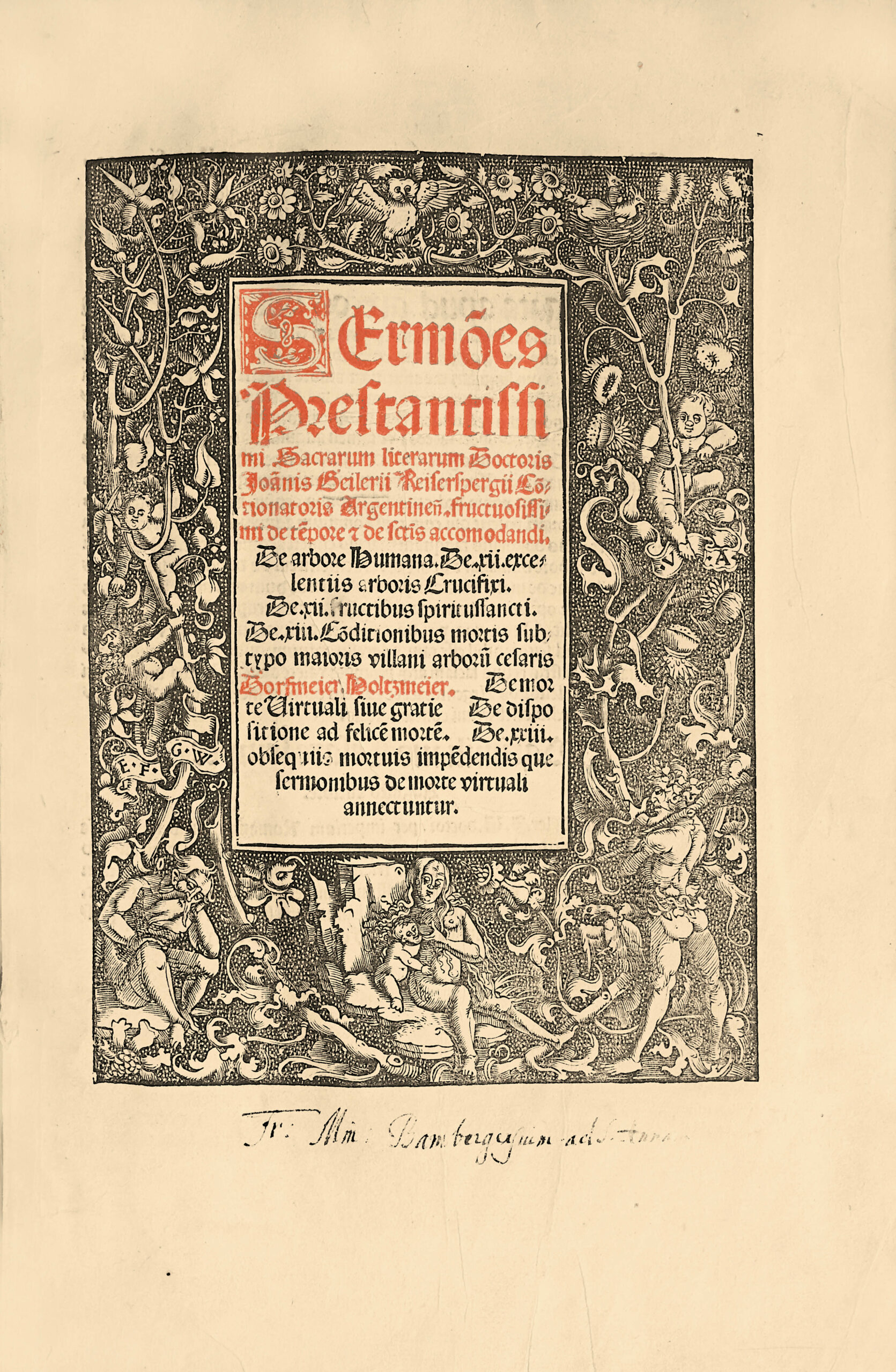Strasbourg, Johannes Grüninger, 1515.
Folio [280 x 190 mm] 6 ll., 214 ll. (the last one is marked CXVI by mistake). Pigskin over wooden boards, blind-stamped bevelled covers with interlacing and floral decoration, spine ribbed, metal clasps, traces of spandrels and cabochons, trace of a chain attachment. Contemporary binding.
Second edition of this series of three sermons preached at the cathedral of Strasbourg between 1495 and 1497 illustrated with a set of “Dances od the Dead” and a title frame in the “dotted ” manner by Hans Wechtlin.
Ritter, 971; Kristeller 155; Muller II:35, 126; Muther 1435; Schmidt 146. See Minns, Dance of Death Collection, 194.
The Dance of the dead by Geyler von Kaysersberg is very rare.
“These sermons were translated into Latin by Jacques Biethen of Riquewihr, and dedicated by him to Conrad Wickram, vicar general of the diocese of Strasbourg, and to Clément Daniel, priest of Ribeauvillé, ex aedibus domini mei Petri Wickram, summae aedis concinatoris. Biethen says that Geiler himself had wished the publication of these sermons, preached in 1495, partly in the cathedral, partly in Sainte-Madeline and in Saint-Nicolas-aux-Ondes.
“Second edition of Geiler’s sermons, illustrated with the same unusual set of woodcuts representing danse macabre subjects that appeared in the first edition of 1514. Geiler, sometimes called the German Savonarola, was a “preacher at the Strassburg cathedral, who attracted huge audiences while advocating reform. Inspired by the ideals of humanism, Geiler composed and delivered sermons that were at once learned and passionate, and above all, accessible to a broad audience.” Carlos M.N. Eire, Reformations: The Early Modern World, 1450-1650 (2016). The title page is printed in the dotted manner or manière criblée or Schrotblatt, a technique found in Germany and France in the late 15th and early 16th centuries, in which the design is created from punches or stamps on a metal plate. Seven woodcuts and numerous woodcut initials also decorate the book”.
Geyler, also called Kaisersberg from the place where he was raised, a famous preacher, was born in Schafhouse on March 16, 1445. He lost his father, a notary in Ammerweiler, at an early age and went to Kaisersberg (in Germany) to live with his grandfather. He was raised by his grandfather in Alsace, studied literature in Freiburg im Breisgau and theology in Basel, where he became a doctor in 1475. He soon distinguished himself in sacred eloquence in Freiburg and Würzburg, and for 30 years, beginning in 1478, he was a preacher at the cathedral in Strasbourg.
‘The Dominicans had until then occupied the pulpit of the cathedral of this city; but scandalous disputes which they had had in 1454 with Jean Cruizer, parish priest of St. Laurent, and with the other parish priests of the city, and indecent propositions which they had spouted in the pulpit of truth, caused these religious to lose shortly afterwards the prerogative of preachers in the cathedral. Geyler devoted himself to the holy ministry with the greatest zeal for thirty consecutive years.
His sermons are a mixture of the sacred and the profane, of Latin and German.
Geyler constantly speaks out strongly against the disorders of the monks of his time. The choice of his images and his expressions, which would hurt our delicate ears today and would only excite laughter, touched our ancestors to tears, and sometimes converted the most hardened sinners. We owe to Geyler’s eloquence the abolition of several abuses against the decency and majesty of divine worship, such as the ceremonies that were performed in the cathedral on the Day of the Innocents and during the week of Pentecost, as well as the nightly assemblies of the Dedication. It is also to his exhortations that the city of Strasbourg owes the first idea of a public school.
Geyler’s sermons attracted such a large audience that the square of the chapel of St. Lawrence, where the pulpit of the basilica was located, soon became too narrow to hold the crowd. So in 1486 this magnificent pulpit was built, which still exists today, according to the drawings of Jean Hammerer, architect of the factory, and according to the ideas of Geyler himself. This sacred speaker was highly considered by Maximilian i, because of his probity and erudition; this emperor often called him to his court, consulted him on the most important matters, and protected him against the enemies which the boldness with which he preached aroused in the speaker…
None of his contemporaries had perhaps a library as considerable and as well chosen as his. He used to write all his sermons, sometimes in Latin, sometimes in German; these manuscripts passed into the hands of his friends and admirers, who published them partly during his lifetime, partly after his death; for he did not have the patience to look after the printing of his works himself…
All of Geyler’s works are curious for the details they contain on the customs and mores of the time of Emperor Maximilian I.” (Michaud, Biographie universelle).
The work contains a wood engraved frontispiece in the “dotted” manner with the initials E.F. G.W. V.A. attributed to Hans Wechtlin as well as 7 woodcuts setting the scene of dances of the Dead one of which is full-page. They are attributed according to the specialists to Hans Baldung Grien.
“Kristeller describes the full-page “Figura Mortis” cut (showing death slaying a whole family) as “a Dance of Death scene of the most moving character.”
Precious copy preserved in its contemporary blind-stamped pigskin over wooden boards.
Handwritten mention on the title: Monastery St Anne Bamberg.







